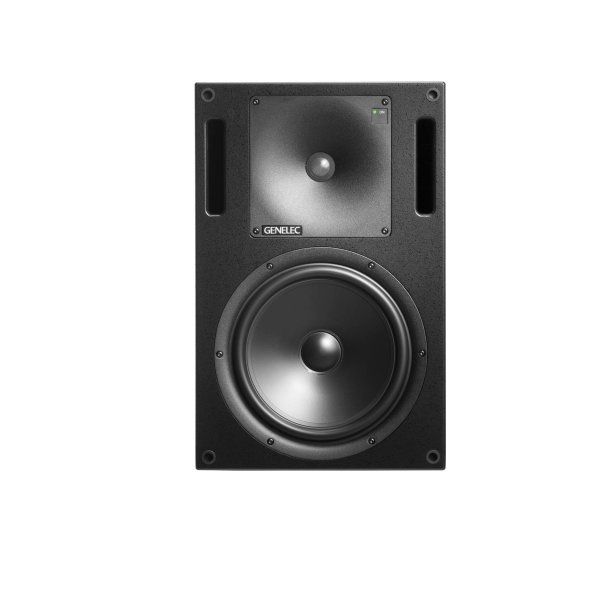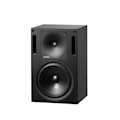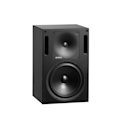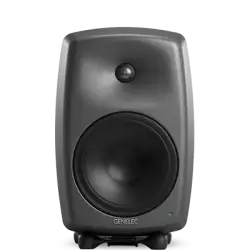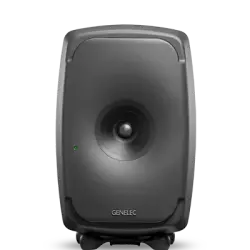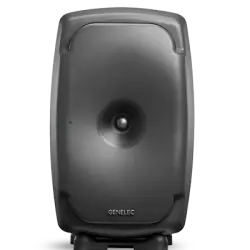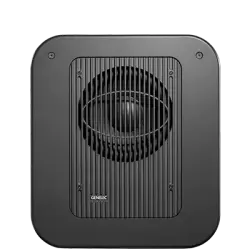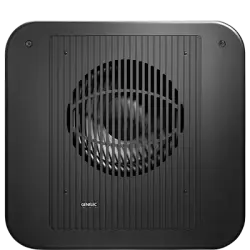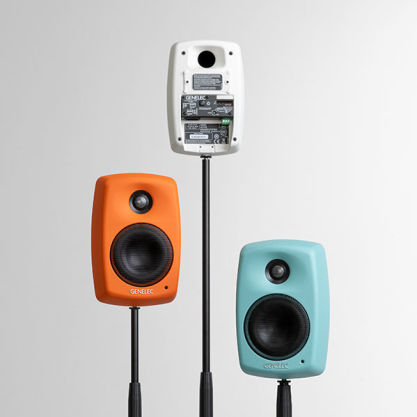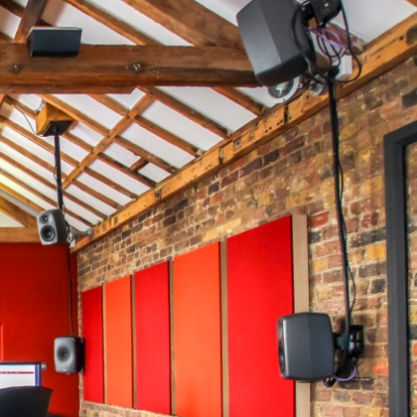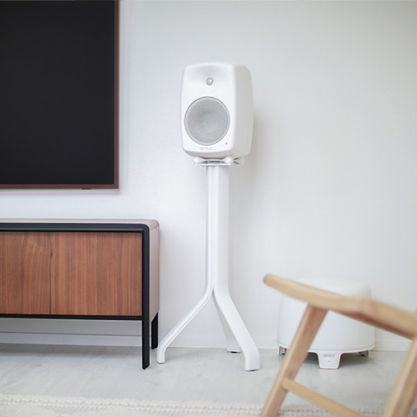El 1032C es un monitor de campo cercano con alto SPL que fusiona el muy querido estilo montable en plafón de la icónica serie 1000 con nuestra última tecnología de monitoreo activo inteligente.
1032C
SAM™ Monitor de Estudio

Active Crossovers

Directivity Control Waveguide (DCW™) Technology

SPL
114 dB

Respuesta en frecuencia
33 Hz - 23 kHz (-6 dB)

Dimensiones
H 495 x W 320 x D 290 mm, (ver en pulgadas)

Mayor y mejor rendimiento
Conservando todas las veneradas características de audio de las versiones A y B anteriores, el 1032C ahora cuenta con conectividad digital, una fuente de alimentación universal y una potente amplificación Clase D; le producir un SPL más alto y una mayor amplitud de baja frecuencia que sus ya potentes predecesores.
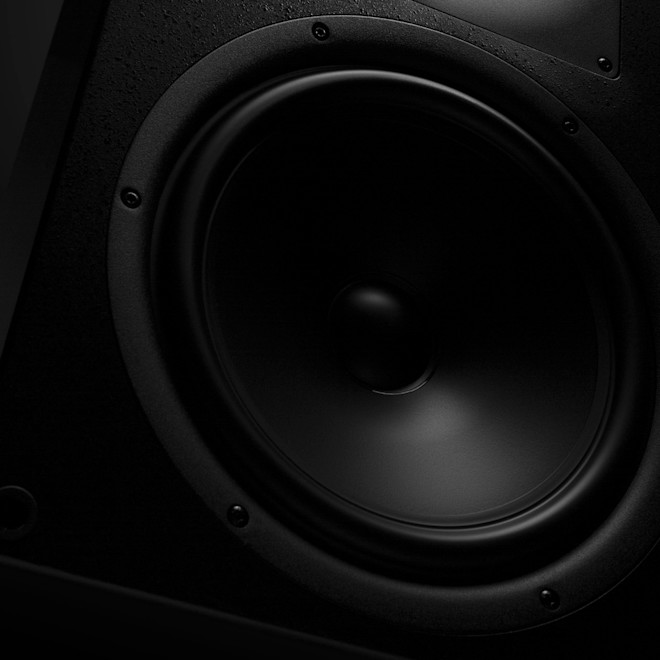
Un clasico ahora Inteligente
Además de su característica neutralidad lista para usar, el 1032C ahora se integra estrechamente con nuestro software GLM a través del cual se puede configurar y calibrar para optimizar su entorno de escucha, compensando las influencias perjudiciales de la sala para crear una solución de monitoreo verdaderamente optimizada. Esto hace que el 1032C sea la elección perfecta para los profesionales de la producción, postproducción y transmisión musical de alto nivel cuyas mezclas deben traducirse perfectamente a otras salas y sistemas.
Especificaciones técnicas

SPL
114 dB

Potencia del amplificador
250 W Bass (Class D) + 150 W Treble (Class D)

Respuesta en frecuencia
33 Hz - 23 kHz ("-6 dB")

Precisión de la respuesta en frecuencia
± 2.5 dB (40 Hz - 20 kHz)

Dimensiones del altavoz
⌀ 250 mm Bass + ⌀ 25 mm Treble (ver en pulgadas)

Dimensiones
H 495 x W 320 x D 290 mm, (ver en pulgadas)

Peso
17 kg / 37.5 lb

Conexiones
1 x XLR Analog Input
1 x XLR AES/EBU Input
1 x XLR AES/EBU Output
2 x RJ45 Control
1032C
SAM™ Monitor de Estudio
Especificaciones técnicas
El 1032C es un monitor de campo cercano con alto SPL que fusiona el muy querido estilo montable en plafón de la icónica serie 1000 con nuestra última tecnología de monitoreo activo inteligente.

Especificaciones del sistema
Respuesta en frecuencia
40 Hz - 20 kHz (± 2.5 dB)
Corte de graves -6 dB
33 Hz
Corte de agudos -6 dB
23 kHz
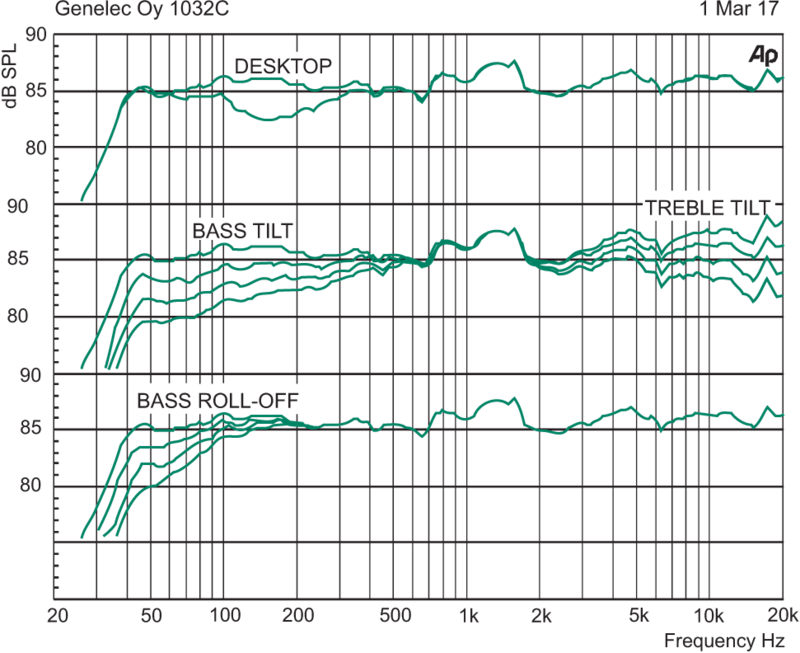
SPL
SPL pico Maximum peak acoustic output per pair in a listening room with music material at 1 m.
≥124 dB
SPL máximo a corto plazo Maximum short term sine wave acoustic output on axis in half space, averaged from 100 Hz to 3 kHz at 1 m.
≥114 dB
Máximo SPL a largo plazo Maximum long term RMS acoustic output in the same conditions with IEC weighted noise (limited by driver protection circuit) at 1 m.
≥104 dB
Ruido propio
Ruido propio Self generated noise level in free space at 1 m on axis (A-weighted).
≤5 dB SPL
Peso
Peso17 kg (37.5 lb)
Dimensiones
Altura
495 mm
Anchura
320 mm
Profundidad
290 mm
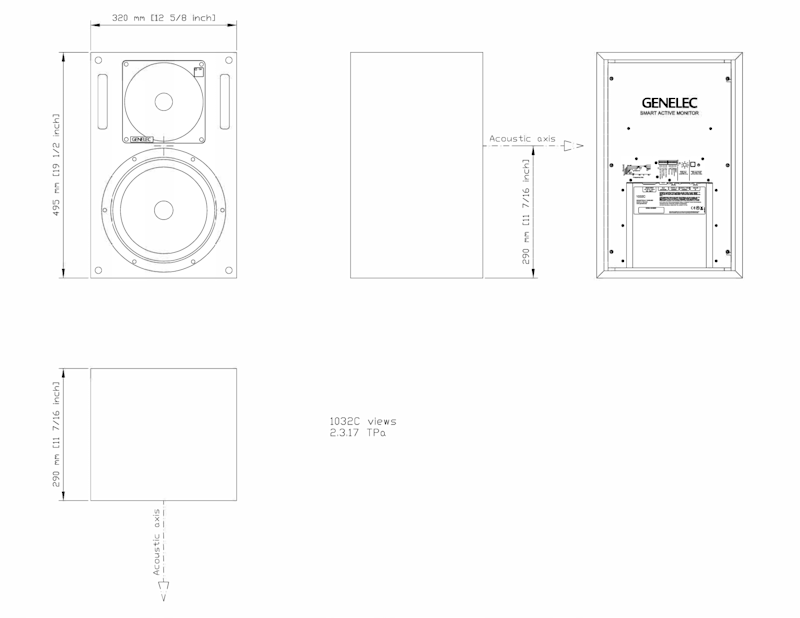
Recinto
Material del recinto
MDF
Altavoces
Tipo de altavoz
Cone
Magnetically shielded bass driver.
Diámetro
250 mm
Tipo de altavoz
Metal dome
Magnetically shielded treble driver.
Diámetro
25 mm
Directividad

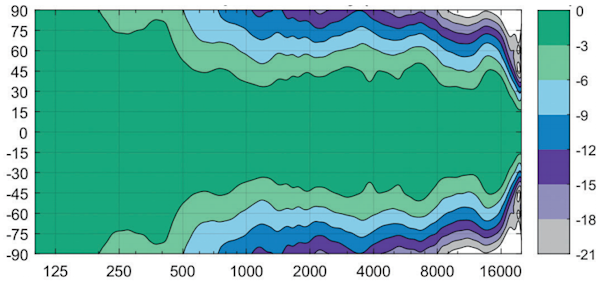
Distorsión armónica
> 100 Hz ≤0.5 %
Retardo de grupo
The latency at high frequencies from the input to the acoustic output, measured in the analog input:
Extended Phase Linearity in GLM set to OFF
3.2 ms
In Genelec performance graphics, the time of converting the from an electronic input signal to the acoustic output in a Genelec monitor is described by two factors – latency and group delay. The group delay factor can be read in the graphics for a specific frequency. The total frequency-specific input-to-output delay is a sum of the latency and group delay factors. To understand the significance of this total delay, consider that moving a loudspeaker away by 1 meter creates an additional delay of about 3 ms.
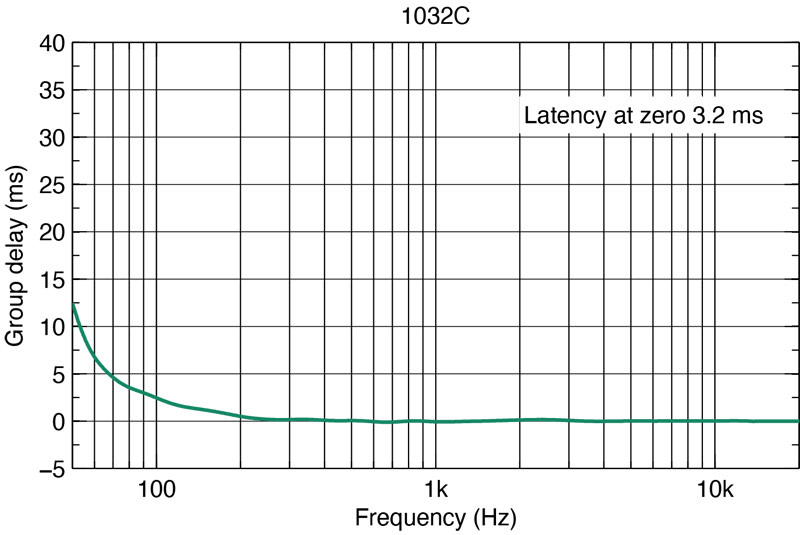
Sección de amplificación
Amplificadores
250 W Class D
150 W Class D
Voltaje de la toma eléctrica
100-240 VAC 50/60Hz
Consumo de potencia
Con ISS activo
≤1 W
En reposo
≤11 W
A pleno rendimiento
200 W
Sección de procesado de señal
Conectores
Input Analog signal input connector XLR female, balanced 10 kOhm.
Input Digital signal input connector XLR female 110 Ohm.
Output Digital signal output / Thru connector XLR male 110 Ohm.
2 x Control Two CAT5 (RJ45) GLM Network connectors for computer control using the Genelec Loudspeaker Manager (GLM) software.
Variantes de producto
Códigos de producto
Accesorios compatibles
Códigos de producto
Para más detalles técnicos consulte por favor el manual de operación del producto
Tecnologías clave

Active Crossovers

Directivity Control Waveguide (DCW™) Technology

Optimised Amplifiers

Protection Circuitry

Room Response Compensation

Smart Active Monitoring (SAM™) and GLM™ calibration technology

Intelligent Signal Sensing (ISS™) Technology
Active crossover operating at low signal levels.

Audio electronic crossovers allow the audio signal to be split into separate frequency bands that are separately routed to individual power amplifiers, which are then connected to specific transducers optimised for a particular frequency band.
Active crossovers come in both digital and analogue varieties. Genelec digital active crossovers include additional signal processing, such as driver protection, delay, and equalisation.
Genelec analogue active crossover filters contain electronic components that are operated at low signal levels suitable for power amplifier inputs. This is in contrast to passive crossovers that operate at the high signal levels of the power amplifier's outputs, having to handle high currents and, in some cases, high voltages.
In a typical two-way system the active crossover needs two power amplifiers — one for the woofer and one for the tweeter.
The active crossover design offers multiple benefits:
- The frequency response becomes independent of any dynamic changes in the driver's electrical characteristics or the drive level.
- There is increased flexibility and precision for adjusting and fine-tuning each output frequency response for the specific drivers used.
- Each driver has its own signal processing and power amplifier. This isolates each driver from the drive signals handled by the other drivers, reducing inter-modulation distortion and overdriving problems.
- The ability to compensate for sensitivity variations between drivers.
- The possibility to compensate for frequency and phase response anomalies associated with a driver’s characteristics within the intended pass-band.
- The flat frequency response of a high-quality active loudspeaker is a result of the combined effect of the crossover filter response, power amplifier responses and driver responses in a loudspeaker enclosure.
Using the active approach enables frequency response adjustments and optimisation of the full loudspeaker system, placed in various room environments, without expensive external equalisers. The end result is a simpler, more reliable, efficient, consistent and precise active loudspeaker system.
Directivity Control Waveguide (DCW™) for flat on and off-axis response.

A revolutionary approach was taken by Genelec in 1983 with the development of its Directivity Control Waveguide (DCW™). We have developed and refined this technology over more than 30 years to greatly improve the performance of direct radiating multi-way monitors.
The DCW technology shapes the emitted wavefront in a controlled way, allowing predictable tailoring of the directivity (dispersion) pattern. To make the directivity uniform and smooth, the goal is to limit the radiation angle so that the stray radiation is reduced. It results in excellent flatness of the overall frequency response as well as uniform power response. This minimises early reflections and provides a wide and controlled listening area achieving accurate sound reproduction on and off-axis.
Minimised early reflections and controlled, constant directivity have another important advantage: the frequency balance of the room reverberation field is essentially the same as the direct field from the monitors. As a consequence, the monitoring system's performance is less dependent on room acoustic characteristics.
Sound image width and depth, critical components in any listening environment, are important not only for on-axis listening, but also off-axis. This accommodates not only the engineer doing their job, but also others in the listening field, as is so often the case in large control rooms.
DCW™ Technology key benefits:
- Flat on and off-axis response for wider usable listening area.
- Increased direct-to-reflected sound ratio for reduced control room coloration.
- Improved stereo and sound stage imaging.
- Increased drive unit sensitivity up to 6 dB.
- Increased system maximum sound pressure level capacity.
- Decreased drive unit distortion.
- Reduced cabinet edge diffraction.
- Reduced complete system distortion.
Each transducer is driven by its own optimised amplifier.

Audio electronic crossovers allow to split the audio signal into separate frequency bands that can be separately routed to individual power amplifiers, which are then connected to specific transducers optimised for a particular frequency band.
In a typical 2-way loudspeaker system, the active crossover needs two power amplifiers — one for the woofer and one for the tweeter. The power amplifiers are connected directly to the drivers of an active loudspeaker, resulting in the power amplifier’s load becoming much simpler and well known. Each driver-specific power amplifier has only a limited frequency range to amplify (the power amplifier is placed after the active crossover) and this adds to the ease of design.
The active design principle offers multiple benefits:
- The power amplifiers are directly connected to the speaker drivers, maximising the control exerted by the power amplifier’s damping on the driver’s voice coil, reducing the consequences of dynamic changes in the driver electrical characteristics. This may improve the transient response of the system.
- There is a reduction in the power amplifier output requirement. With no energy lost in the passive crossover filter components, the amplifier power output requirements are reduced considerably (by up to 1/2 in some cases) without any reduction in the acoustic power output of the loudspeaker system. This can reduce costs and increase audio quality and system reliability.
- No loss between amplifier and driver units results in maximum acoustic efficiency.
- Active technology can achieve superior sound output vs. size vs. low frequency cut-off performance.
- All loudspeakers are delivered as a factory aligned system (amplifiers, crossover electronics and enclosure-driver systems).
Sophisticated drive unit protection circuitry for safe operation.

When working in critical audio production environments it is essential that monitoring systems remain reliable and functional at all times. One of the main reasons behind Genelec’s excellent success in broadcasting environments is the reliability of our products and a key element behind the reliability is the internal protection circuitry found in all products since 1978.
The protection circuitry prevents driver failures by detecting signal levels, and in case of sudden peaks or constantly too high levels, taking the signal level down automatically. Of course this feature does not affect the sound quality in any way when working within the specifications of the loudspeaker, but only prevents inadequate input signals from breaking the loudspeaker.

Protection circuitry features and benefits:
- Reduces the output level when required, (e.g. when driver voice coil temperature reaches the safe limit), which highly improves system reliability.
- Appropriate protection circuitry design in every loudspeaker and subwoofer enables the maximisation of system output sound level.
Precise room response compensation for optimizing in-room performance.

The interaction between room acoustic and loudspeaker radiation is complex. Each room changes somewhat the monitor’s response in a unique way, e.g. reflective vs. damped rooms, or placement against a wall vs. on a stand away from the walls.
All Genelec loudspeaker systems feature room response adjustments to compensate for the room influences and retrieve a flat frequency response at the listening position.
Analogue Systems
Genelec analogue loudspeaker systems provide versatile Room Response Controls. They include (depending on models):
- Bass Roll-Off and Bass Tilt
- Treble Tilt and Treble Roll-Off
- Bass Level
- Midrange Level
- Treble Level
- Desktop Control

At low frequencies two main controls are provided. The Bass Tilt control, which acts as a shelving filter together with the Bass Roll-off control allowing you to optimize the low and very low frequency response of the system in different installations. Bass, midrange and treble level controls are provided in large systems. These controls allow to optimize the relative balance between the various pass bands.
The operating manual and datasheet of each loudspeaker contains a list of preferred room response control settings for different installations. These have been specified out of long practical experience and measurements of various kind of typical acoustic environments.
Smart Active Monitor (SAM™) Systems
Genelec SAM Systems offer a comprehensive, solution-oriented, intelligently networked product range which all feature Genelec Loudspeaker Manager (GLM™) software and its automatic calibration system called AutoCal™.
Genelec AutoCal provides the industry’s first integrated process for complete automated measurement, analysis, and adjustment of every monitor on the GLM control network. The system measures the response in the listening area and applies relevant compensation in the low and low-mid frequencies to minimise the detrimental room acoustic anomalies as well as the differences between various listening positions. AutoCal also aligns relative levels, time-of-flight, as well as adjusts correct crossover phase (called AutoPhase) for all subwoofers on the network.

The Acoustic Response Editor provides accurate graphical display of the measured response, filter compensation and the resulting system response for each monitor, with full manual control of acoustic settings.
Networked Smart Active Monitor (SAM™) Systems feature automatic calibration to the environment.

Now, more than ever, audio productions are engineered in tighter, more confined working environments. This increases acoustic problems and lowers the reliability of monitoring. At the same time, an audio engineer's need to trust a reliable and precise monitoring system that reproduces sound neutrally and without distortion has not changed.
Built upon the solid electro-acoustic foundations of our 1200, 8000 and 7000 Series products, Genelec SAM Systems are today’s most advanced and flexible monitoring solutions. They are an indispensable tool for audio professionals, as they automatically adapt to the acoustic environment and correct for level, delay and room anomalies. SAM Systems are controlled using Genelec's proprietary Loudspeaker Manager (GLM™) network and software, enabling you to build a highly flexible and reliable monitoring system.
GLM is a highly intuitive and powerful monitor control networking system that manages connectivity to all SAM studio monitors and subwoofers on the network. GLM software features adjustment of level, distance delay and flexible room response compensation equalisation with our state-of-the-art, highly robust AutoCal™ 2 algorithm automated calibration system. All parameters and settings are stored in system setup files or saved in each individual monitor or subwoofer, if the GLM network needs to be disconnected.
Also, all acoustical features of SAM Systems can be optimised and tailored for different working styles or client demands. Additionally, even if the monitors or the production projects move between rooms, you can expect SAM technology to provide the highest consistency in monitoring, providing neutral soundstage imaging with low distortion – in each environment.
Genelec SAM Systems offer a comprehensive, solution-oriented, intelligently networked product range supporting analogue and digital signals in virtually any working environment.
Intelligent Signal Sensing (ISS™) for power consumption reduction in stand-by mode.

Introduced early 2013, Genelec’s Intelligent Signal-Sensing technology has been developed to meet with both European Union ErP Directives and Genelec's own ambitious sustainability standards.
The Intelligent Signal Sensing, ISS™ circuitry tracks the signal input of the loudspeaker and detects if it is in use. If the ISS circuit does not find any audio on the input for a period of time, it sets the loudspeaker to a low-power sleep state and the loudspeaker will consume less than 0.5 watts. When an input signal is detected, the loudspeaker immediately turns itself on.
Additionally an ‘ISS Disable’ switch is located on each product’s back plate next to the other room response controls. First, when the mains power switch of the loudspeaker is set to 'ON', the ISS™ auto-start function (low-power sleep state on/off) of the loudspeaker is active.

If this function is not desired, the ISS™ function can be disabled by setting the 'ISS Disable' switch on the back panel to 'ON' position. In this mode, the monitor is only powered on and off using the mains power switch.
Note that the mains power switch will always turn the monitor off completely.
Referencias
Genelec UNIO Explained | How the ecosystem offers seamless in-room and personal headphone monitoring
Usando GLM | Tutorial
Using GLM | The foundations
Using GLM | Controlling GLM with MIDI
Using GLM | GRADE Room Acoustic Report
Using GLM | Calibration Group IDs
Using GLM | Accounts and product registration
Using GLM | The technical details
Genelec UNIO Explained | How the ecosystem offers seamless in-room and personal headphone monitoring
A quick guide to our UNIO Ecosystem – which offers audio engineers seamless bridging of in-room and personal headphone monitoring. https://genelec.com/UNIO
The Genelec UNIO Ecosystem – which combines the power of our renowned GLM, SAM Monitoring and Aural ID adaptive technologies – gives audio engineers the flexibility to work anywhere, anytime, from stereo to immersive. And now, with the new UNIO Personal Reference Monitoring (PRM) solution, audio professionals benefit from the pinpoint accuracy of our pioneering active monitoring headphone solution, which combines the 9320A SAM Reference Controller with uniquely factory-calibrated 8550A Professional Reference Headphones.
To learn more, visit https://genelec.com/UNIO
"Verblüffende Raumkorrektur im Genelec 1032CPM Test – dieser Studiomonitor kann mit Sound, Verarbeitung und einer optionalen Raumkorrektur voll überzeugen. Wer für sein Tonstudio einen Lautsprecher auf hohem Niveau sucht, wird in diesem Review fündig."
Quelle: www.delamar.de
{"fi-FI":"delamar Magazine's (DE) online review "Genelec 1032CPM Test: Überzeugender Studiomonitor" was published in August 2018. The review is in German.\n\nRead the full review: [Genelec 1032CPM Testbericht](https://www.delamar.de/test/genelec-1032cpm/ "Genelec 1032CPM Testbericht")","ru-RU":"delamar Magazine's (DE) online review "Genelec 1032CPM Test: Überzeugender Studiomonitor" was published in August 2018. The review is in German.\n\nRead the full review: [Genelec 1032CPM Testbericht](https://www.delamar.de/test/genelec-1032cpm/ "Genelec 1032CPM Testbericht")","de-DE":"delamar Magazine's (DE) online review "Genelec 1032CPM Test: Überzeugender Studiomonitor" was published in August 2018. The review is in German.\n\nRead the full review: [Genelec 1032CPM Testbericht](https://www.delamar.de/test/genelec-1032cpm/ "Genelec 1032CPM Testbericht")","en-US":"delamar Magazine's (DE) online review "Genelec 1032CPM Test: Überzeugender Studiomonitor" was published in August 2018. The review is in German.\n\nRead the full review: [Genelec 1032CPM Testbericht](https://www.delamar.de/test/genelec-1032cpm/ "Genelec 1032CPM Testbericht")","sv-SE":"delamar Magazine's (DE) online review "Genelec 1032CPM Test: Überzeugender Studiomonitor" was published in August 2018. The review is in German.\n\nRead the full review: [Genelec 1032CPM Testbericht](https://www.delamar.de/test/genelec-1032cpm/ "Genelec 1032CPM Testbericht")","es-ES":"delamar Magazine's (DE) online review "Genelec 1032CPM Test: Überzeugender Studiomonitor" was published in August 2018. The review is in German.\n\nRead the full review: [Genelec 1032CPM Testbericht](https://www.delamar.de/test/genelec-1032cpm/ "Genelec 1032CPM Testbericht")"}
"Genelec bringt ein verbessertes, digitales Modell der beliebten 1032er-Serie auf den Markt. Mit erweiterten Features und der Integration ihrer smarten Boxensteuerung rüstet der finnische Hersteller Genelec den neusten Spross der erfolgreichen Modellreihe für komplexe Studiosetups. Im bonedo-Test müssen die Boxen zeigen, was sie können."
-Patric Louis, the author of the review article
{"fi-FI":"Bonedo Magazin's (DE) online review "Genelec 1032C Test - 2-Wege-Studiomonitor" was published in January 2018, and it is written by Patric Louis. The review is available in German.\n\nRead the full review [here](https://www.bonedo.de/artikel/einzelansicht/genelec-1032c-test.html "Genelec 1032C Test - 2-Wege-Studiomonitor").","ru-RU":"Bonedo Magazin's (DE) online review "Genelec 1032C Test - 2-Wege-Studiomonitor" was published in January 2018, and it is written by Patric Louis. The review is available in German.\n\nRead the full review [here](https://www.bonedo.de/artikel/einzelansicht/genelec-1032c-test.html "Genelec 1032C Test - 2-Wege-Studiomonitor").","de-DE":"Bonedo Magazin's (DE) online review "Genelec 1032C Test - 2-Wege-Studiomonitor" was published in January 2018, and it is written by Patric Louis. The review is available in German.\n\nRead the full review [here](https://www.bonedo.de/artikel/einzelansicht/genelec-1032c-test.html "Genelec 1032C Test - 2-Wege-Studiomonitor").","en-US":"Bonedo Magazin's (DE) online review "Genelec 1032C Test - 2-Wege-Studiomonitor" was published in January 2018, and it is written by Patric Louis. The review is available in German.\n\nRead the full review [here](https://www.bonedo.de/artikel/einzelansicht/genelec-1032c-test.html "Genelec 1032C Test - 2-Wege-Studiomonitor").","sv-SE":"Bonedo Magazin's (DE) online review "Genelec 1032C Test - 2-Wege-Studiomonitor" was published in January 2018, and it is written by Patric Louis. The review is available in German.\n\nRead the full review [here](https://www.bonedo.de/artikel/einzelansicht/genelec-1032c-test.html "Genelec 1032C Test - 2-Wege-Studiomonitor").","es-ES":"Bonedo Magazin's (DE) online review "Genelec 1032C Test - 2-Wege-Studiomonitor" was published in January 2018, and it is written by Patric Louis. The review is available in German.\n\nRead the full review [here](https://www.bonedo.de/artikel/einzelansicht/genelec-1032c-test.html "Genelec 1032C Test - 2-Wege-Studiomonitor")."}
fairaudio HiFi-Magazin's (DE) online review of 1032C SAM™ Studio Monitor. The review is written in German. Published in December 2017.
{"fi-FI":"fairaudio HiFi-Magazin's (DE) online review "Klassiker mit klaren Kanten" was published online on 11th December, 2017. It is written by Nick Mavridis.\n\nRead the full review in German: [fairaudio: 1032C Review](https://www.fairaudio.de/test/genelec-1032-c-aktiv-lautsprecher-test/ "fairaudio: 1032C Review").","ru-RU":"fairaudio HiFi-Magazin's (DE) online review "Klassiker mit klaren Kanten" was published online on 11th December, 2017. It is written by Nick Mavridis.\n\nRead the full review in German: [fairaudio: 1032C Review](https://www.fairaudio.de/test/genelec-1032-c-aktiv-lautsprecher-test/ "fairaudio: 1032C Review").","de-DE":"fairaudio HiFi-Magazin's (DE) online review "Klassiker mit klaren Kanten" was published online on 11th December, 2017. It is written by Nick Mavridis.\n\nRead the full review in German: [fairaudio: 1032C Review](https://www.fairaudio.de/test/genelec-1032-c-aktiv-lautsprecher-test/ "fairaudio: 1032C Review").","en-US":"fairaudio HiFi-Magazin's (DE) online review "Klassiker mit klaren Kanten" was published online on 11th December, 2017. It is written by Nick Mavridis.\n\nRead the full review in German: [fairaudio: 1032C Review](https://www.fairaudio.de/test/genelec-1032-c-aktiv-lautsprecher-test/ "fairaudio: 1032C Review").","sv-SE":"fairaudio HiFi-Magazin's (DE) online review "Klassiker mit klaren Kanten" was published online on 11th December, 2017. It is written by Nick Mavridis.\n\nRead the full review in German: [fairaudio: 1032C Review](https://www.fairaudio.de/test/genelec-1032-c-aktiv-lautsprecher-test/ "fairaudio: 1032C Review").","es-ES":"fairaudio HiFi-Magazin's (DE) online review "Klassiker mit klaren Kanten" was published online on 11th December, 2017. It is written by Nick Mavridis.\n\nRead the full review in German: [fairaudio: 1032C Review](https://www.fairaudio.de/test/genelec-1032-c-aktiv-lautsprecher-test/ "fairaudio: 1032C Review")."}
Encuentra tu representante

Documentación
Reseñas
delamar Magazin (online): Genelec 1032CPM Test: Überzeugender Studiomonitor, August 2018 (DE) Bonedo Magazin (online): Genelec 1032C Test - 2-Wege-Studiomonitor, January 2018 (DE) fairaudio: Klassiker mit klaren Kanten, December 2017 (DE) AudioVideo.fi - Genelec 1032C -aktiivikaiuttimet ja 7380A -aktiivisubwoofer testissä, November 2017 (FI) HifiStudio: Genelec 1032C – vanhan klassikon päivitetty versio huonekorjauksella, December 2017 (FI)"Verblüffende Raumkorrektur im Genelec 1032CPM Test – dieser Studiomonitor kann mit Sound, Verarbeitung und einer optionalen Raumkorrektur voll überzeugen. Wer für sein Tonstudio einen Lautsprecher auf hohem Niveau sucht, wird in diesem Review fündig."
Quelle: www.delamar.de
delamar Magazine's (DE) online review "Genelec 1032CPM Test: Überzeugender Studiomonitor" was published in August 2018. The review is in German.
Read the full review: Genelec 1032CPM Testbericht
"Genelec bringt ein verbessertes, digitales Modell der beliebten 1032er-Serie auf den Markt. Mit erweiterten Features und der Integration ihrer smarten Boxensteuerung rüstet der finnische Hersteller Genelec den neusten Spross der erfolgreichen Modellreihe für komplexe Studiosetups. Im bonedo-Test müssen die Boxen zeigen, was sie können."
-Patric Louis, the author of the review article
Bonedo Magazin's (DE) online review "Genelec 1032C Test - 2-Wege-Studiomonitor" was published in January 2018, and it is written by Patric Louis. The review is available in German.
Read the full review here.
fairaudio HiFi-Magazin's (DE) online review of 1032C SAM™ Studio Monitor. The review is written in German. Published in December 2017.
fairaudio HiFi-Magazin's (DE) online review "Klassiker mit klaren Kanten" was published online on 11th December, 2017. It is written by Nick Mavridis.
Read the full review in German: fairaudio: 1032C Review.
"Hillitön määrä puhdasta ääntä, hurjasti tarkkuutta ja etenkin kaiutinjärjestelmän häviäminen musiikin tieltä tavalla, jota ei äkkiseltään arvaisi."
-Samu Saurama, the author of the review article
AudioVideo.fi website's (FI) online review of the Genelec 1032C studio monitor and 7380A subwoofer. The review was published in November 2017.
Read the full review in Finnish here.
"Genelecin 1032C on päivitetty painos vanhasta 1032A/B-aktiivikauttimesta, joka on ollut yksi Genelecin suosituimpia kaiuttimia tässä kokoluokassa. Lähinnä kaiutinta on käytetty studioissa tarkkailumonitorina, mutta myös kotikäytössä musiikin kuuntelussa. Uudessa kaiuttimessa on vanhaan verrattuna isoimpina muutoksina D-luokkaiset päätevahvistimet ja GLM-huonekalibrointi."
-Lauri Eskola, the author of the review article
HifiStudio website's (FI) online review of the Genelec 1032C studio monitor. The review was published in December 2017.
Read the full review in Finnish here.
hello

